What's this digital transformation guide about? Well, this guide will explain everything related to digital initiatives: their importance, benefits, challenges, meaning, framework, technologies, examples, KPIs, essential components, and trends.
Yes, digital transformation has been the buzzword for quite some time now in this hyper-reactive digital age. Every board meeting discussion, CIO's plan, and business manager's to-do list revolves around this term.
It promises to improve businesses' ROI, revenue, productivity, streamlined business processes, and product and service quality.
Compared to the localized trade and seldom connected marketplace of the past, today's world is heavily digitized and better connected. The digital market is the playground for modern business owners to create omnichannel interactions with customers and prospects.
The said interaction is carried out via websites, mobile apps, social media channels, customer success strategies, and other outreach campaigns. This digital shift has pushed many C-level executives to take or at least plan the path toward transformation or digitization of their legacy operational processes.
A journey of a thousand miles begins with a single step – Lao Tzu
We feel that it’s the journey that should be worth it, especially for your customers. And depending on whom you ask, digital transformation holds different meanings.
For us, it means understanding and decoding the problem statements, creating a framework, listing down the best technology stack, and helping develop a digital solution that drives business innovation and solves problems while keeping you profitable. In this guide, we will help you understand
- What digital transformation exactly is?
- How can you implement various technologies to counter the roadblocks of your current business processes?
- How can you create a much more efficient business operation and increase the success rate in your industry vertical?
What is digital transformation?
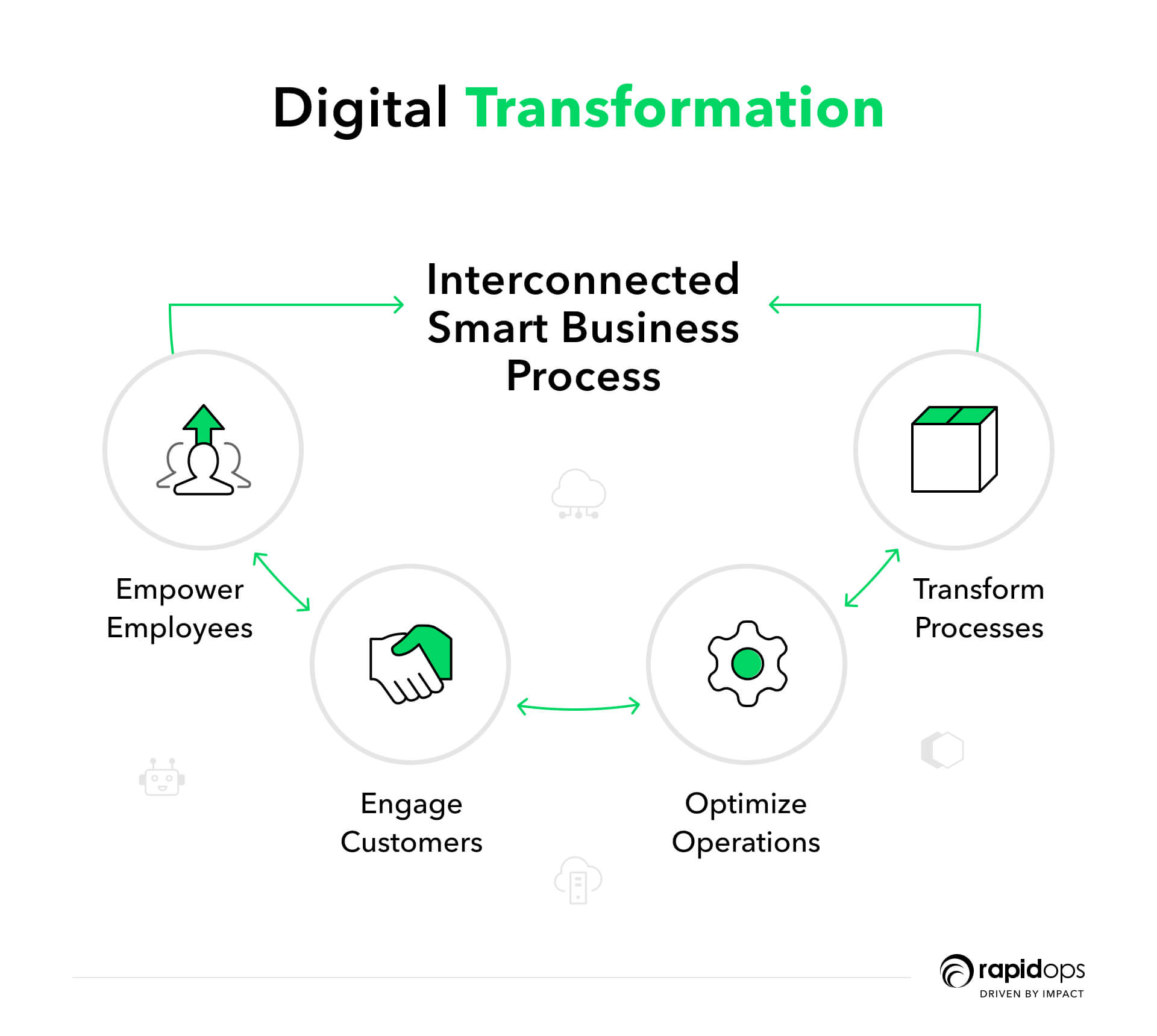
Digital transformation helps businesses digitize their traditional and non-digital processes to meet the ever-growing marketplace and customer demand.
Understanding digital transformation means realizing it is not just about having a website, app, or software to digitize your business. It's about radically rethinking entire business models, processes, customer experiences, etc., from the ground up.
When an organization decides to opt for digital transformation, it takes the initiative to become a digitally driven enterprise. It builds a sturdy base with the help of relevant technology that can create more time for the workforce and function with a digital-first approach.
You have to list and choose which modern technology can help you reinvent your business entirely and develop a clear digital transformation roadmap. If you cut corners, you will only make minor incremental improvements.
While you are busy making these small, compartmentalized changes, the competitors that have taken a more radical approach will outpace you.
- Understand the challenges involved in planning the transformation initiative.
- List down the steps required for creating the digital transformation strategy.
- Take note of the resources (technologies, workforce, methodologies) required for successful implementation.
- Be in the loop about the present and upcoming digital transformation trends.
- Keep a checkbox of KPIs ready to track the success or implementation of organization-wide digital transformation.
- Make a list of digital delivery partners that can help you transform your business to make it more scalable.
We will be further covering all of these points in our guide today, so sit back and enjoy.
Hint: Do not treat digital transformation as a one-time process. It is an evolution, and you have to be continually adaptive to the constantly changing business environment.
Discover the Keys to Digital Transformation Success with Our Comprehensive Guide.
Download Now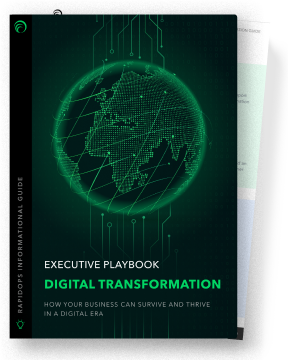
What are the types of digital transformation?
When an organization embarks on re-imagining its business, it needs to consider these 4 main areas of digital transformation –
1. Process transformation
Under process transformation, key elements of the business process must be modified. Companies that opt for process transformation aim for
- Business modernization
- Integrating cutting-edge technology
- Saving process costs
- Streamlining their core systems with the entire process
2. Business model transformation
Modern businesses want to transform their traditional business model with innovation and reinvention. Such an initiative requires major changes in the company's business model. The major motive behind the business model transformation is to get new growth opportunities.
3. Domain transformation
The rise in technological integration in the business process is
- Redefining traditional products and services
- Blurring the traditional industry boundaries
- Creating new non-traditional competitors
New technologies provide tangible business growth opportunities to companies beyond their traditional market domain. Domain transformation allows businesses to create better value for customers in this segment.
4. Organizational and cultural transformation
Under this transformation initiative, businesses aim to redefine their organization’s mindsets, processes, and capabilities. This is done to match the expectation of a more digitally-driven long-term business initiative. Organizations that opt for such digital transformation initiatives aim to create
- Flexible workflow
- Decentralized decision-making process
- Greater resilience to the different business ecosystem
Why is digital transformation important?
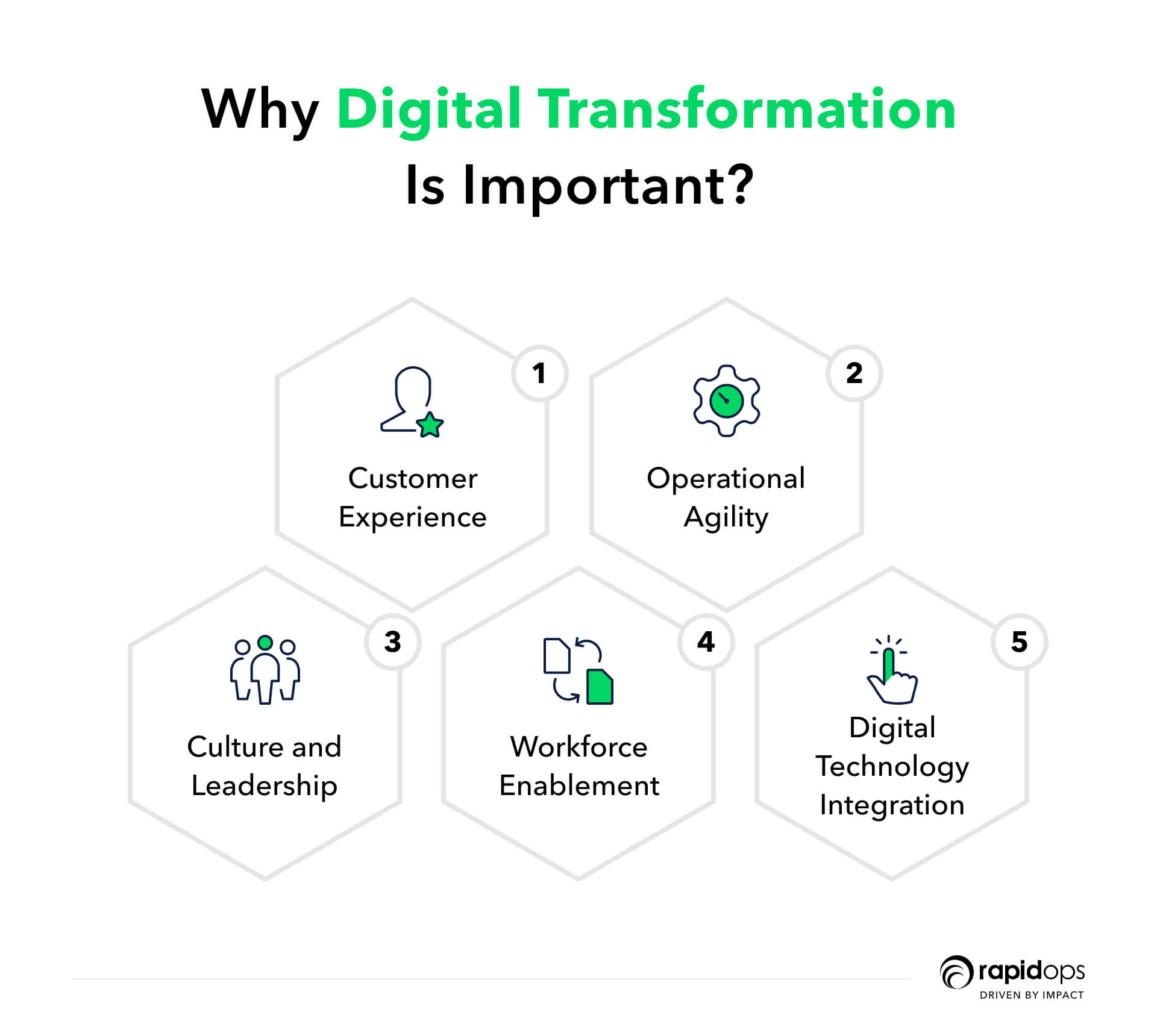
“Digital transformation spending will grow to more than 53% of all information and communications technology (ICT) investment by 2023, up from 36%” – IDC
Most organizations will undergo some digital transformation in their lifetime. Understanding the benefits of digital transformation and using the right technology is often the key to staying competitive. But what worked ten years ago might not work today and will soon become obsolete.
The most important lesson that this pandemic has taught every industry is that taking the path of digitization will help them move closer to technological divinity. In short, going digital is the way to go forward. No compromises there.
Read More: How digital transformation is beneficial to keep the Covid-19 pandemic in check?
However, it is easier said than done. Just adopting the latest or cutting-edge technology will not be enough to fulfill the organizational transformation. They need to consider many factors that can be beneficial for their initiative. We will be covering the essential factors in this guide.
You need digital transformation to
- Get better insights into your business process and its functions
- Create new business opportunities
- Drive your business efficiently towards realizing the revenue goals
- Manage and enhance the customer experience
- Increase the sales and revenue figures
With a pinch of automation, courtesy AI/ML, and an add-on of data analytics at the helm of your business intelligence, you can be the master of the most treacherous sea!
What are the top digital transformation challenges?
Digital transformations empower organizations to create the solid foundation required to be future-ready. They also help them position themselves firmly amongst the competition and grow into newer, profitable verticals.
What are the challenges in digital transformation?
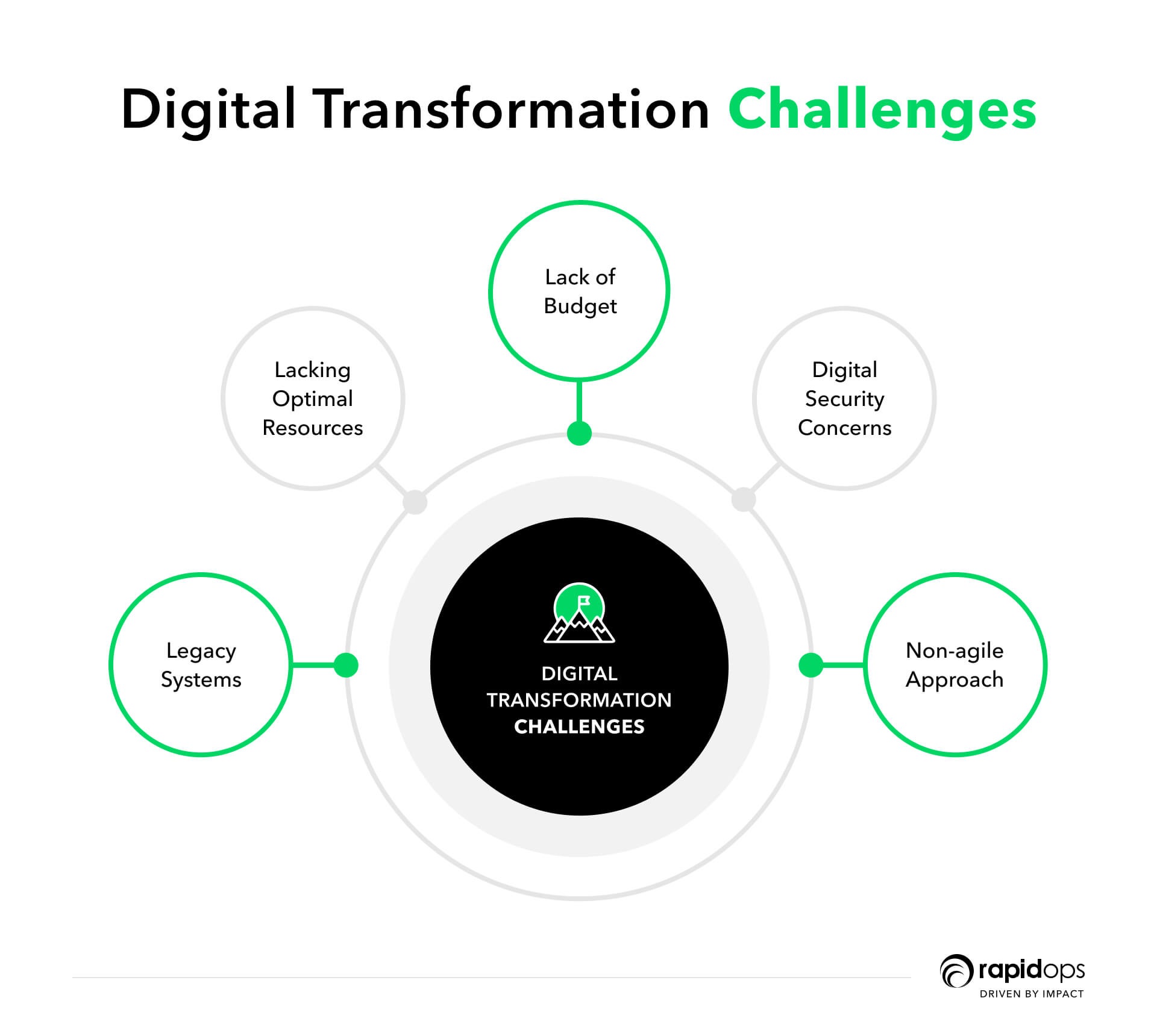
Organizations must consider that taking on a digital transformation initiative comes with its fair share of challenges. Let’s look at some of them here.
1. Dependency on a legacy system
There is a misconception that digital transformation can be achieved with upgraded tools and technologies. Digital transformation doesn’t solely depend on tools and technologies; it depends on your organization's/workforce’s adaptability to change and move beyond traditional legacy systems.
Significant shortcomings in digital transformation initiatives are due to resistance to change within the organization. Even with a fail-safe strategy, digital transformation will be challenging if the business leader is not ready to innovate their business model and modernize their legacy system.
2. Organization lacks the resources and expertise
An organization will always face a challenge in implementing digital transformation if it mismanages its resources. Addressing the digital workforce shortage before starting the digital transformation journey is imperative.
Digital transformation is not just about having the right tools and digitizing the processes. It is about having the expertise to successfully implement, manage, and refine those tools to digitize the process.
Now, you would be asking, “How feasible is it to hire digital product experts every time I invest or plan to invest in new tools and technologies?”
It's probably not feasible. However, it’s about the importance of hiring a digital product consultant who has proven their ability to transform an organization digitally successfully.
3. Lack of digital transformation budget
Business leaders need to have a clear-cut goal for their capital and operation expenditure required for undertaking the digital transformation initiative.
It is impossible to set up a straightforward budget, but businesses must acquire the right technology and digital experience team.
The digital transformation initiative will require some capital; however, eventually, this investment will lead to better profitability.
4. The agenda of digital security
Everything that comes with going digital has the added concern for security. Most business leaders are always concerned about cybersecurity as it is complex, dynamic, and ever-changing.
If you are concerned about the successful integration of digital technologies in your current organizational architecture, you will have to find a way to secure its digital functionality.
5. The issue of agility
As a business owner, you would not like to wait an eternity for your digital transformation strategy to be implemented. Agility is undoubtedly one of the significant challenges of digital transformation.
So, it becomes essential that organizations opt for agile transformation for a successful and faster digital transformation implementation.
What are the benefits of digital transformation?
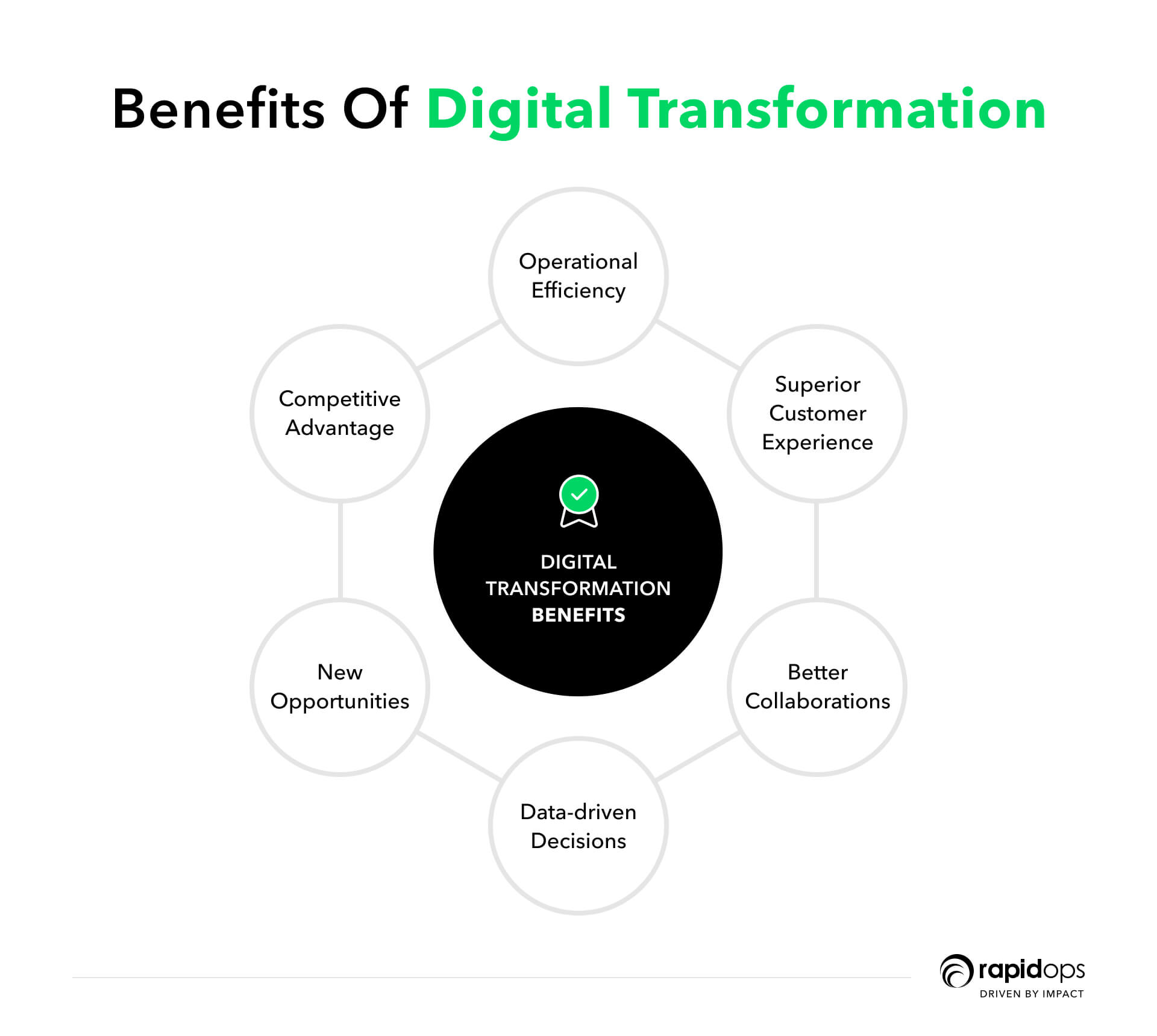
"Digital business is not about technology because most digital technologies provide possibilities for efficiency gains and customer intimacy. But if people lack the right mindset to change and the current organizational practices are flawed, DT will simply magnify those flaws" - HBR
Digital transformation looks, feels, and means different things to different companies. This difference exists because of the differences in their industry verticals. Let’s take a general approach to the benefits of creating not only organizational and operational change but also cultural change.
Producing products at affordable cost and scaling operations with the anticipation of profitable business growth are the key focus areas of organizational digital transformation efforts.
Let’s see some of the crucial digital transformation benefits for businesses
1. Enhanced operational efficiency and lowered costs
In our previous conversation about legacy system modernization, we mentioned the amount of money organizations spend to maintain them. Yes, the transition requires significant investment upfront, but it saves time and money as the new processes become more efficient.
Digitally transformed organizations can effectively use all the integrations and centralizations to become strategic and data-driven while making timely decisions. Over time, with streamlined processes, agility, and innovation, companies can save much money, easing their budget to other vital segments that run their business.
With digitization, you can automate your manual tasks and business processes, such as
- Customer data collection
- Account changes
- Status updates
- Procurement
- Tech support ticket management
- Invoicing
- Time tracking
- Payroll
2. Superior customer experience
91% of consumers say they are more likely to shop with brands that provide offers and recommendations that are relevant to them. – Accenture
When businesses have a streamlined data repository, tracking everything related to the customers becomes more manageable.
Personalization is a crucial driver for modern businesses, and to scale this, you need to go digital with a bang! There is an abundance of digital technologies that business owners can use to gain insight into their customer interactions, interests, and engagement.
The use case varies for different industry verticals, but in general, knowing customers, their behaviors, needs, and requirements and fulfilling them improves the customer experience.
This helps businesses improve customer retention by creating more personalized and rich customer touchpoints, which in turn starts adding to overall organizational revenue growth.
3. Increased collaboration across departments
When you digitally transform your business processes, you enable your workforce to communicate frequently and better across the company.
Co-workers can share business-critical information with their peers across departments to better understand the processes bottlenecks and dependencies, enhancing their collaboration.
A digitized work environment incorporates an agile digital system that is much faster for record-keeping, decision-making, and carrying out other routine processes or tasks.
Digital transformation infuses automation in these processes and allows the workforce to collaborate better.
4. Actionable insights from data
Organization-wide digital transformation allows faster capturing, storing, and analysis of a large volume of data. This helps them make crucial business decisions and streamline the entire process.
Digitization of business operations provides access to volumes of critical data. It gets more comfortable for you to track various metrics like
- Process effectiveness
- Funnel conversion rates
- Customer lifetime value
- Customer satisfaction and much more
You get organized data that is easily accessible to your team. Moreover, you can base all your business decisions on this curated data set. What did you achieve? Less guesswork while making decisions, with boosted efficiency and ascending revenue.
5. Disruptions in products and services for better time-to-market
Digital transformation allows businesses to disrupt their services and product development process to gain better time-to-market.
With technology taking center stage, organizations can use tools that allow faster collaborations and help them innovate or disrupt their traditional approach to product development.
General Electric uses 3-D printers for creating fuel nozzles that are more robust, faster to create, and less expensive.
6. Improvement in competitive advantage
When organizations opt for digitization, they understand the need to match their competition within their industry vertical. With upgraded systems and data integrations, businesses can get better insight into their customer databases.
Based on various insights, they can start planning product features and functionalities. The same wisdom can help them understand where they have an edge over their competitors.
Creating the digital transformation framework
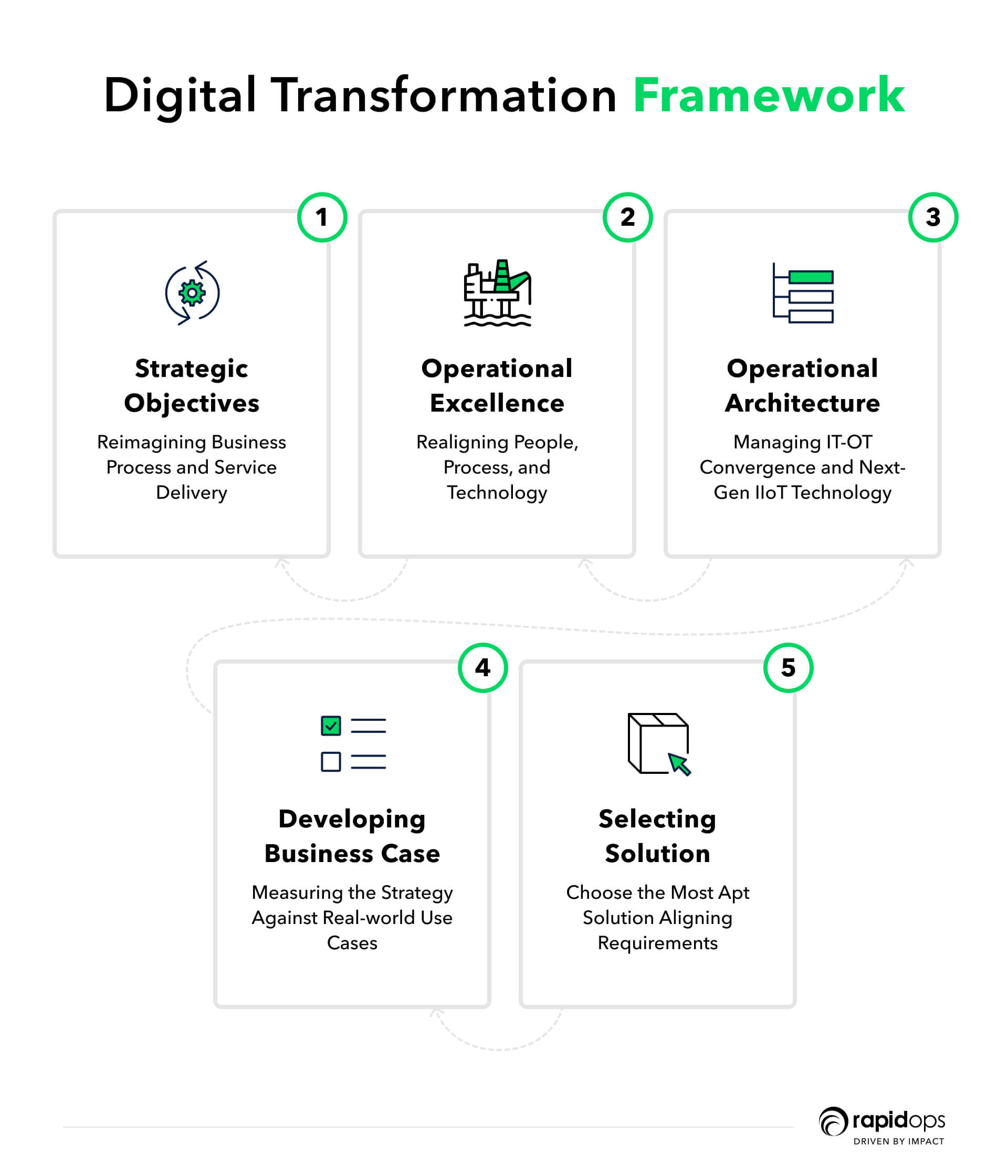
For successful digital transformation of organizational processes, business leaders must create and use a structured digital transformation framework that connects transformation initiatives and related roles. Let’s help you create and understand the framework.
1. Setting strategic objectives
Business leaders need to ask themselves this fundamental question: “What is going to be the long-term value that my company can leverage with the best technology?” Most importantly, they should try to find technological relevance, as it is a crucial factor in legacy upgrades.
Decision-makers are always considering how innovative technologies, like the IIoT, can disrupt and transform their products, value chain, and connected service delivery. Developing a comprehensive transformation roadmap is essential to finding technological relevance and planning legacy upgrades.
On a strategic level, the planning must consider 5-10-20 years. The CEO and COO must work together on strategic planning, and the plan must be built around their organization’s competitive differentiators.
Business leaders have to plan on changing the very nature of service delivery. They can do so by building upon existing models, such as
- Industry 4.0
- Smart Manufacturing
- Digital Twins
2. Seeking operational excellence
When an organization creates operational excellence initiatives, they rely on the right mix of people, processes, and technology. The senior-most leaders of the organization undertake these initiatives.
Every modern company needs to develop maturity models for their business operations as it helps them set better goals and have a growth plan. It also allows them to have better metrics programs to gauge their operations' overall achievements.
3. Creating a sound operational architecture
The enterprise architecture is managed by IT organizations traditionally. It focuses on creating a robust process for growing the enterprise application landscape with a more supportive IT stack.
With the emergence of technologies like IIoT, the manufacturing industry is now adopting better solutions to manage its IT-OT convergence. For an effective convergence, industrial companies must create smart connected assets and operations systems that enable the success of this new collaboration.
4. Developing a business case
Once the above three points are taken care of, start developing the business case for the organization's digital transformation. Business case development initiatives must be driven by deep subject matter experts who understand “the process” and “the technology.”
The next step is to identify these experts in hybrid IT/OT roles in advanced manufacturing. They also can be leaders within specific business functions.
Note: Industrial companies must never view technology investments as a one-off business case. They should treat it as a business case journey that aligns with organizational system architecture goals. It should focus on operational excellence maturity and must support long-term strategic objectives.
5. Selecting the apt organizational solution
Selecting the solution is essential. It must be a quantitative process that eliminates bias and has a dedicated team for its successful incorporation under change management. If all the steps are followed, businesses will find the apt solution much faster.
What are the technologies in digital transformation?
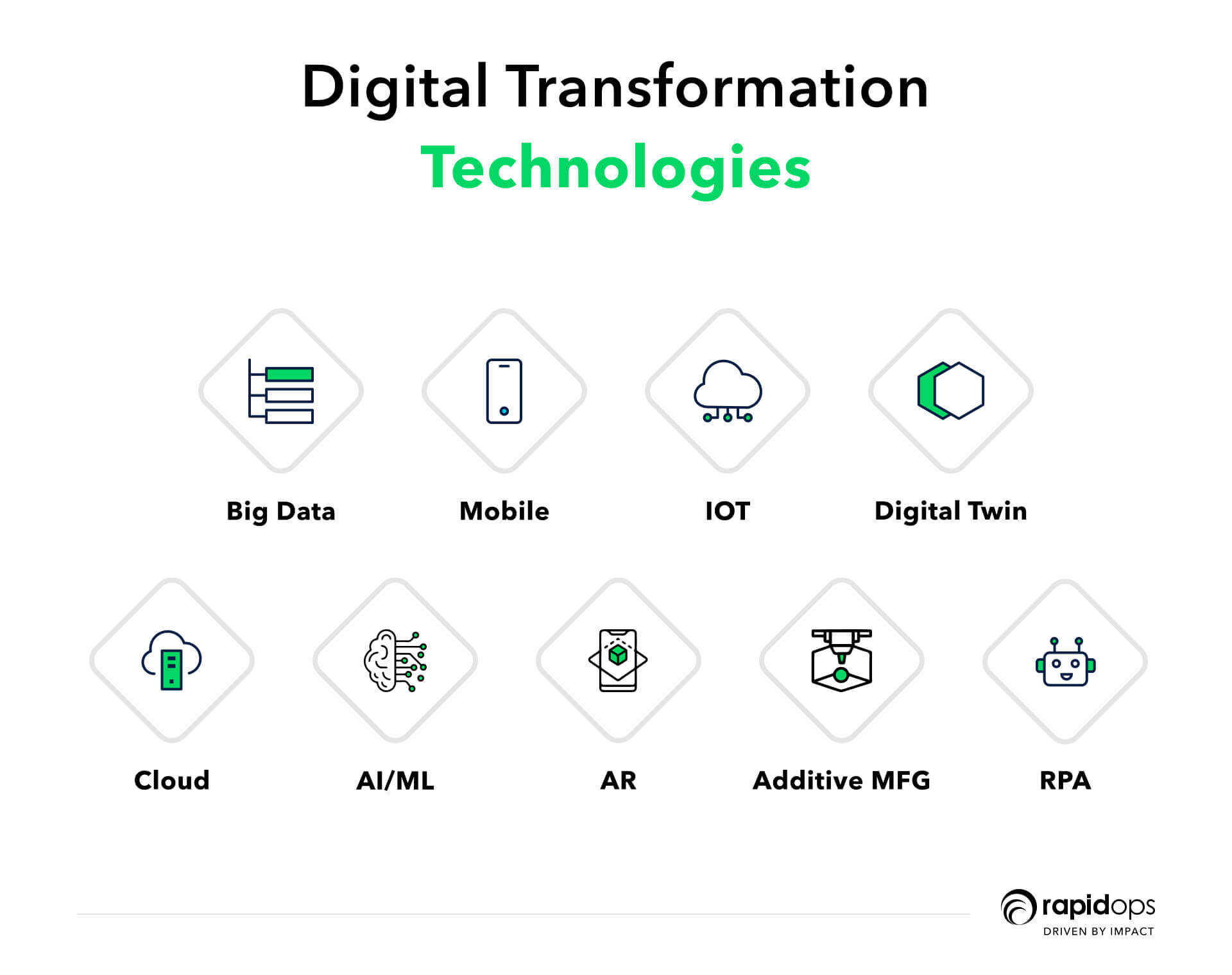
Fusing technologies to create a better process is central to digital transformation initiatives. So, how can this guide miss out on mentioning the technologies helping organizations disrupt their operations? These are the technologies businesses can include in their digital innovation playbook for carrying out organizational digitization initiatives.
1. Big data analytics
With the increase in connected devices in the past few years, proper data accumulation has never been more critical. The number of data generated within an organization will only increase in the future.
Most organizations have fragmented datasets and find it challenging to organize and crunch them to create great business insights. Big data analytics will continue to make its presence felt in faster, real-time data processing, providing tangible insights that businesses can use to become more efficient.
2. Mobile
Today, mobile applications bring better adaptability and portability to businesses. Mobile is a powerful component necessary for other technologies like AR, IoT, etc. It can facilitate real-time communication between organizations and their workforce, which has been a boon for manufacturing, construction, supply chain and logistics, and agriculture.
3. IoT
IIoT is allowing the manufacturing industry to grow with leaps and bounds. It also enables manufacturers to create efficient processes with more safety, flexibility, and innovation.
IoT (Internet of Things), coupled with 5G, holds the promise of making many industries more efficient. IoT devices need better bandwidth to gain faster transmission capabilities and seamless connectivity. 5G deployment will soon make this a reality.
4. Digital Twin
A digital twin is a digital copy of a physical attribute, such as products, processes, and tasks. Organizations can simulate, measure, and predict information from a physical counterpart in the digital world.
Digital twins will help enterprises make real-time data-driven decisions, create better processes, explore new business opportunities, and innovate their current business processes.
5. Cloud technology
Cloud technology is a core component of the digital transformation technology stack, providing organizations with much-needed flexibility, scalability, and agility. Based on their requirements, organizations can choose between different types of cloud services.
Cloud technology allows businesses to seamlessly handle massive data sets in a secure and cost-effective manner.
6. AI/ML
Not limited to science fiction, artificial intelligence and machine learning are helping the automobile, healthcare, retail, and smartphone industries improve their performance. The integration of data analytics, machine learning, and high-performance computational AI is assisting their operations in becoming efficient and beneficial.
7. Augmented Reality
AR is transforming industries with its analytical outcome and human-machine interaction. The technology assists businesses in improving their productivity, providing better training and even better customer support.
It holds the potential to help companies take a transformative approach and will disrupt human interaction with digital systems.
8. Additive Manufacturing
Additive manufacturing (AM), aka 3D printing, will soon see excessive growth and revolutionize the manufacturing industry. It helps produce goods cost-effectively, efficiently, and with minimal production costs.
9. RPA (Robotic process automation)
Digital transformation holds one of the most prominent promises to businesses for streamlining their redundant tasks to use other technologies to generate better automation opportunities.
Robotic process automation is one such technology that is part of an adequate automation armory.
RPA works by successfully integrating AI and ML technologies and helping organizations remove mundane tasks from their workforce’s tasks so that they can focus on other business areas.
Does your organization need a digital transformation strategy?
We already covered digital transformation at the start of this article. Here, we will understand what it means for the industry.
In short, digital transformation is the application of digital capabilities to an industry's processes, products, and assets. Industries must do it regularly to stay efficient, increase customer value, manage and mitigate risk, and realize new revenue generation opportunities.
The said transformation is global and involves adopting digital technologies that come in handy while managing both internal and external operations. To adapt to the worldwide technological disruption and innovation that occurs due to digitization, business leaders must
- Fundamentally disrupt their operation
- Accept cultural changes
- Keep themselves updated with the modern disruptive forces
Having capital investment for cutting-edge technologies is not enough for successful digital transformation.
You have to find out which section of your process needs immediate transformation, what resources you will need to accomplish that, how you will execute those strategies, and how you will counter the challenges that will block its implementation.
What are the essential components of digital transformation?
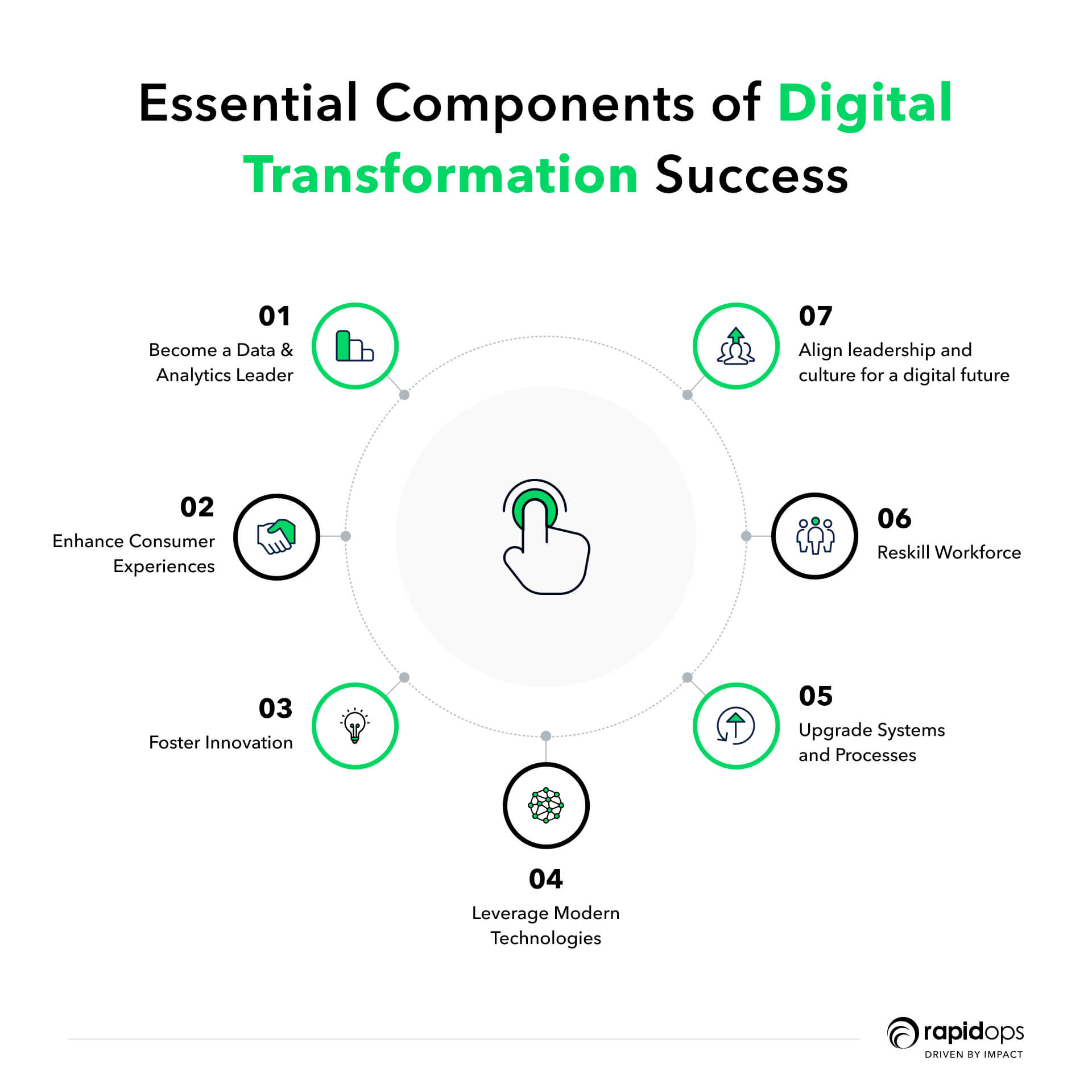
Digital transformation is here, and it is here to stay. The pandemic has fast-tracked its progress, and companies that had just planned to implement it have started or are finding suitable ways to do so. We hope that this guide has been a significant help till now. Let us highlight the essential components that businesses must know for a successful digital transformation.
1. Experiences
If a business understands the customer journey, behavior, and expectations before investing in technology, it will become “customer-experience centric.”
Every leading company focuses on the customer experience and creates a deep connection with its customer base.
Businesses cannot ignore employee experiences, either. Their employees' interactions while working with the chosen technological stack will shape their communication with customers.
2. People
Not having the right talent or not focusing on employee interaction will cause the organizational digital transformation to fail.
This is an extension of customer and employee experience, as a business can never meet its organizational goal without a suitable investment in nurturing the workforce.
As technology like AR, VR, ML, and AI start taking center stage in the work environment, it will be critical for business leaders to create meaningful human-to-human experiences
3. Change
Change is the only constant! Yes, and without it, or the will of change, organizational digital transformation initiatives will not be enough. The workforce must be on the same page as the organization to take the digitization initiative forward.
A business leader must clearly communicate their expectations of the transformation to the employees and inculcate an environment that is ready to accept the change.
4. Innovation
Innovation is necessary for transformation that can entirely change the business. Some innovations are so massive that they disrupt business processes and models.
Some innovations are not incremental but help businesses differentiate their products and services or enhance the customer experience. Whatever the magnitude of innovation, its successful implementation throughout the organization is the key to successful digital transformation.
5. Leadership
There is a notion that an organization’s CEO is always at the helm of digital transformation. If they are not involved, the digitization initiative might fail. A top-level executive needs to be proactive and know the complete pipeline.
A CEO understands the business model and processes and has a better understanding of the need for technological infusion. People in leadership roles must take their sweet, limited time to examine and understand everything before digitizing.
6. Culture
When you tie all these above points together, you create an organizational culture ready to move ahead, embrace innovative technology to become scalable and profitable, and resist change.
The culture here denotes the habit of embracing technological disruption and innovation to stay relevant and competitive. If an organization blindly deploys digitization initiatives, chooses the technologies and tools, and hires a talent that is not an organization fit, it won’t experience successful digital transformation.
Key players of your digital organizational transformation
This section will see the key roles essential for your digital organizational change.
Chief Innovation Officer working with the CTO
CIOs play a role at the intersection of business and technology and often have a strong IT background. Their part is to drive innovation by understanding both business goals and the technological capabilities of software and infrastructure.
Technology-innovation managers
They are hired to work alongside the CIO or CDO to remove any blockers, such as informational and technical gaps, to embrace a company-wide digital strategy.
Integrators
Integrators work at specific departments to ensure that each team implements new digital solutions soundly.
What are some of the digital transformation trends?
What are the top digital transformation trends that business leaders need to know about? We are enlisting the most important ones.
Read More: Discover the Top Digital Transformation Trends for 2023 - Infographic
1. Enterprises will become more agile
CIOs will expand agile practices across departments to reshape business models and change the company culture. The multidisciplinary agile teams will include
- Marketing
- Operations
- Finance
- HR
- Sales
2. Low-code for better customer and employee experience
Digital leaders are now using a mixture of low-code, remote process automation and integration technologies for improving customer and employee experiences at a larger scale.
3. Cloud computing will make headway into multi-cloud architecture
It becomes easier to support vendor platforms for the IT department to manage system resources and Kubernetes clusters across multiple clouds with multi-cloud environments. This also enables businesses to enable edge computing for low-latency workloads.
4. Real-time data processing
Newer cloud architectures that scale on-demand, open-source data platforms, real-time data streaming platforms, and event-driven architectures allows CIOs to update data in real-time.
5. Simplified MLOps
With the rise in MLOps, enterprises will start applying machine learning models to production in 2022.
What are the KPIs for digital transformation success measurement?
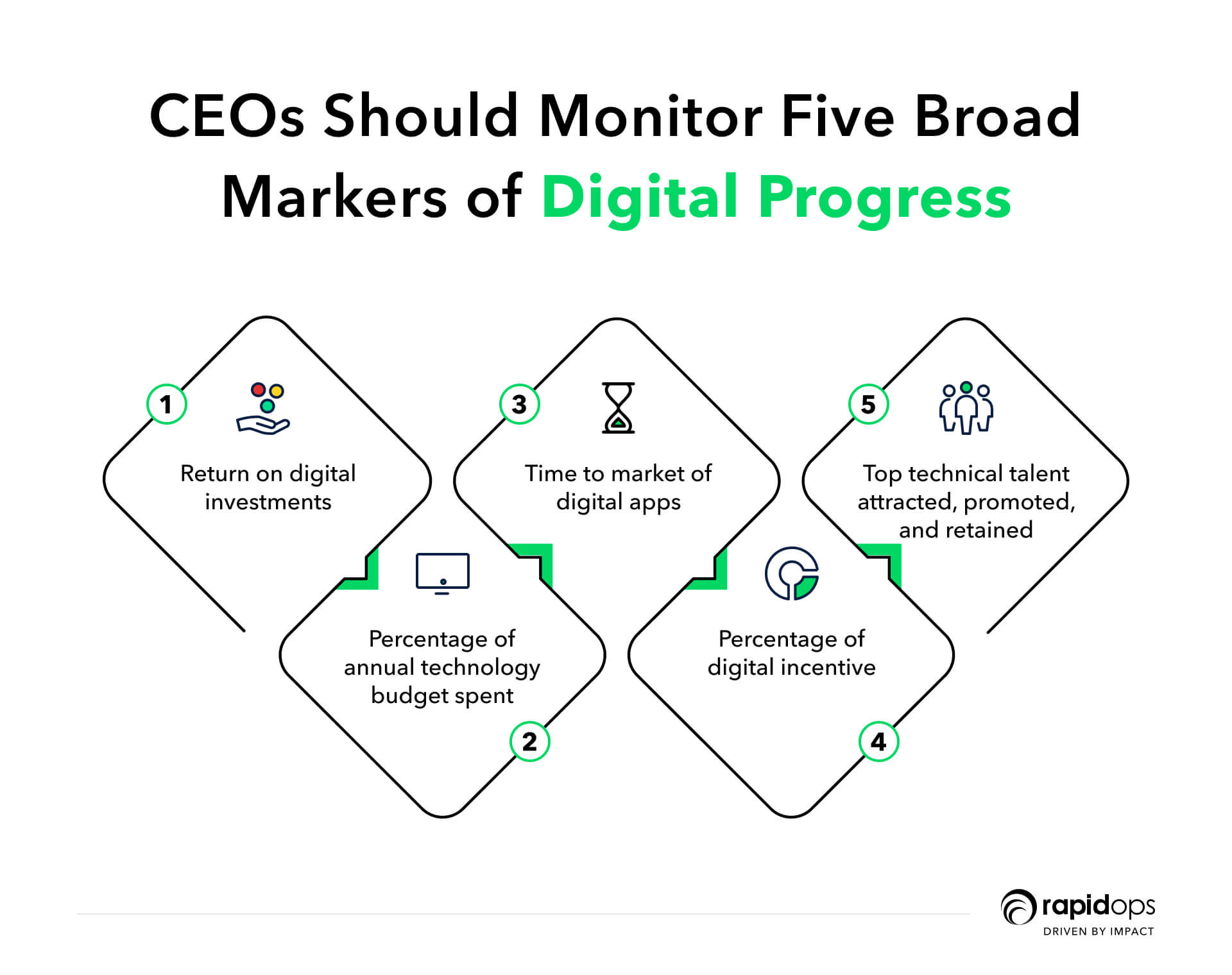
How can an organization track the progress or the outcome of its digital transformation initiatives? Is there a way they can gauge their efforts? Let’s take a look at the KPIs for measuring digital transformation success.
1. Cost-benefit analysis
Were you able to leverage the supposed digital tools to their capacity and achieve the desired result? What are the outcomes of adopting a particular digital technology in your business process? Is there a change in the customer satisfaction rate after the digital disruption? How much money did your organization save after digitizing the customer interaction and automating the customer service?
2. User engagement and participation level
Is there a sustainable adoption of the technology? How many active users are there of your digital assets? Are you checking daily active users, conversion rates, and abandon rates? How successful is your organization's digital adoption?
Important metrics to understand employee engagement patterns:
- Net Promoter Score
- Exit rate
- Employee satisfaction index
- Bounce rate
3. Adoption and performance metrics
Adoption highlights the proper usage of your digital transformation tools by the employees. A poor adoption and performance rate means either the tool is too complex with many confusing functionalities or has a terrible user experience, causing lesser user engagement.
4. Workforce productivity and digital capabilities
To understand the impact of digital transformation efforts, it is crucial to gain insight into employee productivity. This is measured by calculating the value of your employees' output relative to time using your selected tool.
Some real-world and successful digital transformation examples
In today's era of volatility, there is no other way but to re-invent. The only sustainable advantage you can have over others is agility. That's it. Because nothing else is sustainable, everything else you create, somebody else will replicate - Jeff Bezos, Founder, Amazon
Why would organizations carry out their digital transformation initiatives if they cannot relate to its success? Well, here are some of the successful digital transformation examples to give them much-needed confidence.
1. Nike
Nike disrupted its process and focused on mobile devices to reach its audience more effectively, using advanced technologies based on machine learning recommendation algorithms.
The company modernized its mobile app and allowed users to search for the best shoes by scanning their legs. The app creates a map of the feet based on 13 data points, which will be used to create better products in the future.
2. Elevate
Millions of Elevate's US customers live paycheck to paycheck. As a tech-based credit solutions company, Elevate is tasked with customers' financial wellness. Without the right digital tools, it was hard for Elevate to manage and process their customers' financial health.
They were also unable to measure the time required per incoming call. In addition, there was no visibility on the number of resolved support tickets against the sign-ups. This was an exceedingly complicated process as Elevate could not address client issues and make the necessary emergency funds available to them.
They disrupted this process by combining two different digital products: live chat support and online forms. Live chats allow agents to have multiple conversations and resolve issues faster.
At the start of the chat, contact forms allowed them to feed the data into the system and track their clients' crucial information. The data also allowed them to understand the volume of customers interacting with support where they were facing issues during the application process.
3. IKEA
IKEA is a classic example of how digital experience can help a traditional organization successfully disrupt its processes. By incorporating modern technologies, IKEA continuously enhances its customers' shopping experience and optimizes its overall cost.
The furniture company uses AR in its IKEA Place application to help customers choose furniture and virtually “furnish” their apartment before purchasing.
4. Audi
Audi City is a digital world created to replace the lack of traditional showrooms. The digital world enables users to get acquainted with the entire car catalog and also see its interiors or even hear the sound it makes while driving!
A surreal customer experience is bound to make heads turn in the automotive industry, which is a prime example of being analog.
Concluding thought: Choosing the right partner for your digital transformation initiative
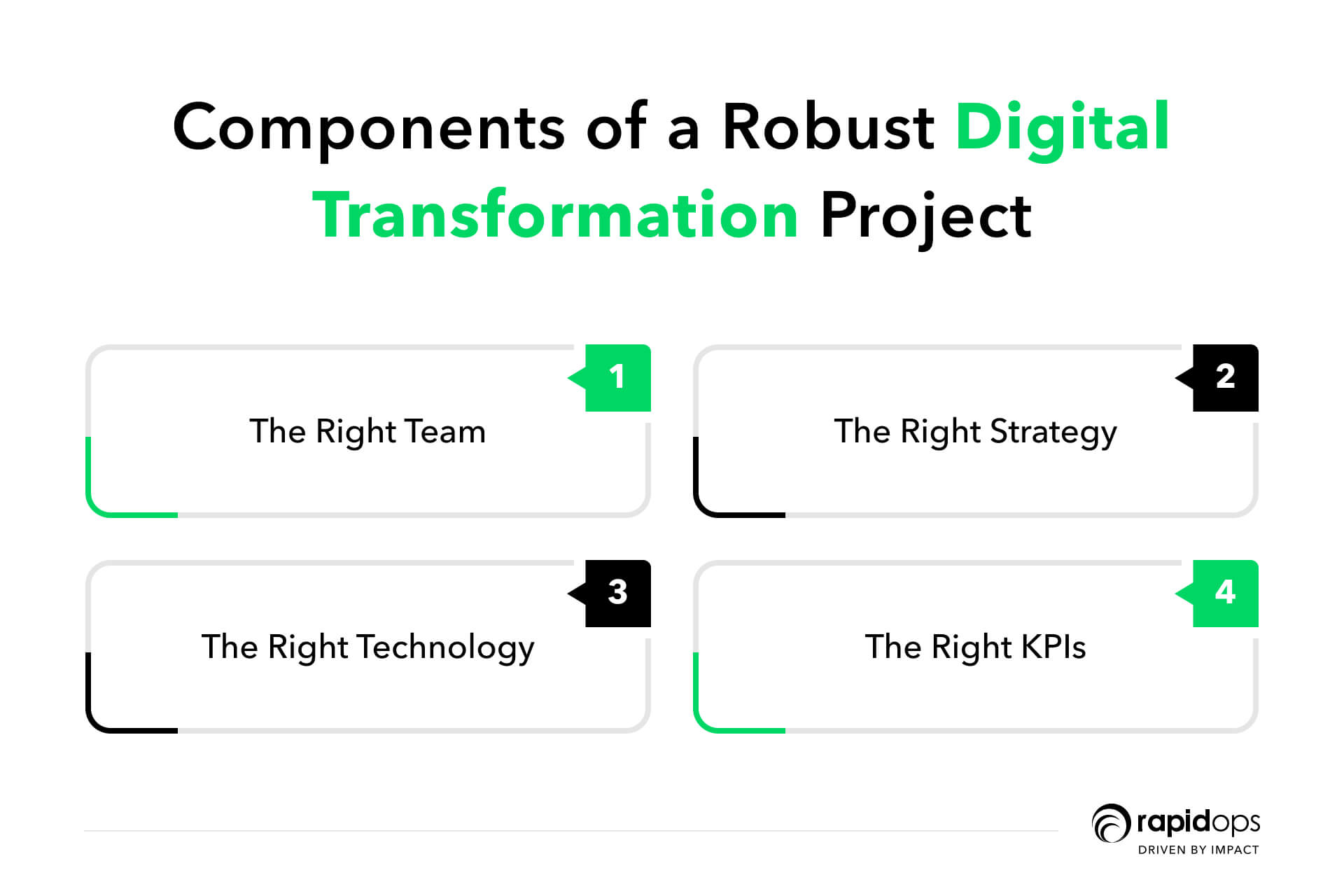
Digital transformation looks different for different companies. It is not only an organizational and operational change but also a cultural change. It requires companies to challenge their old business practices and seek better solutions continually.
The focus areas for business transformation have typically been producing products at affordable cost and scaling operations digitally to aid or anticipate business growth.
However, companies must never get stuck with incremental changes to their business processes. Given that you know the grey areas of your organization that need immediate attention, you can still take a segmented approach to digital transformation.
In the quest for better scalability, ROI, and profitability, organizations need to understand which portion or part of their business process requires digitization. Based on that, they can start framing the strategy, selecting the resources, shortlisting the technology, and implementing it.
Sometimes, transforming an organization means disrupting its business model and bringing more innovation to its processes. Yes, it can be a very daunting task, and having a digital innovation specialist as a technology advisor can help businesses sail smoothly through digital transformation service expertise.

Saptarshi Das
Content Editor
9+ years of expertise in content marketing, SEO, and SERP research. Creates informative, engaging content to achieve marketing goals. Empathetic approach and deep understanding of target audience needs. Expert in SEO optimization for maximum visibility. Your ideal content marketing strategist.
What’s Inside
- What is digital transformation?
- What are the types of digital transformation?
- Why is digital transformation important?
- What are the top digital transformation challenges?
- What are the benefits of digital transformation?
- Creating the digital transformation framework
- What are the technologies in digital transformation?
- Does your organization need a digital transformation strategy?
- What are the essential components of digital transformation?
- Key players of your digital organizational transformation
- What are some of the digital transformation trends?
- What are the KPIs for digital transformation success measurement?
- Some real-world and successful digital transformation examples
- Concluding thought: Choosing the right partner for your digital transformation initiative

Let’s build the next big thing!
Share your ideas and vision with us to explore your digital opportunities
Similar Stories
- Transformation
- undefined Mins
- March 2022

- Transformation
- undefined Mins
- March 2020


Receive articles like this in your mailbox
Sign up to get weekly insights & inspiration in your inbox.

